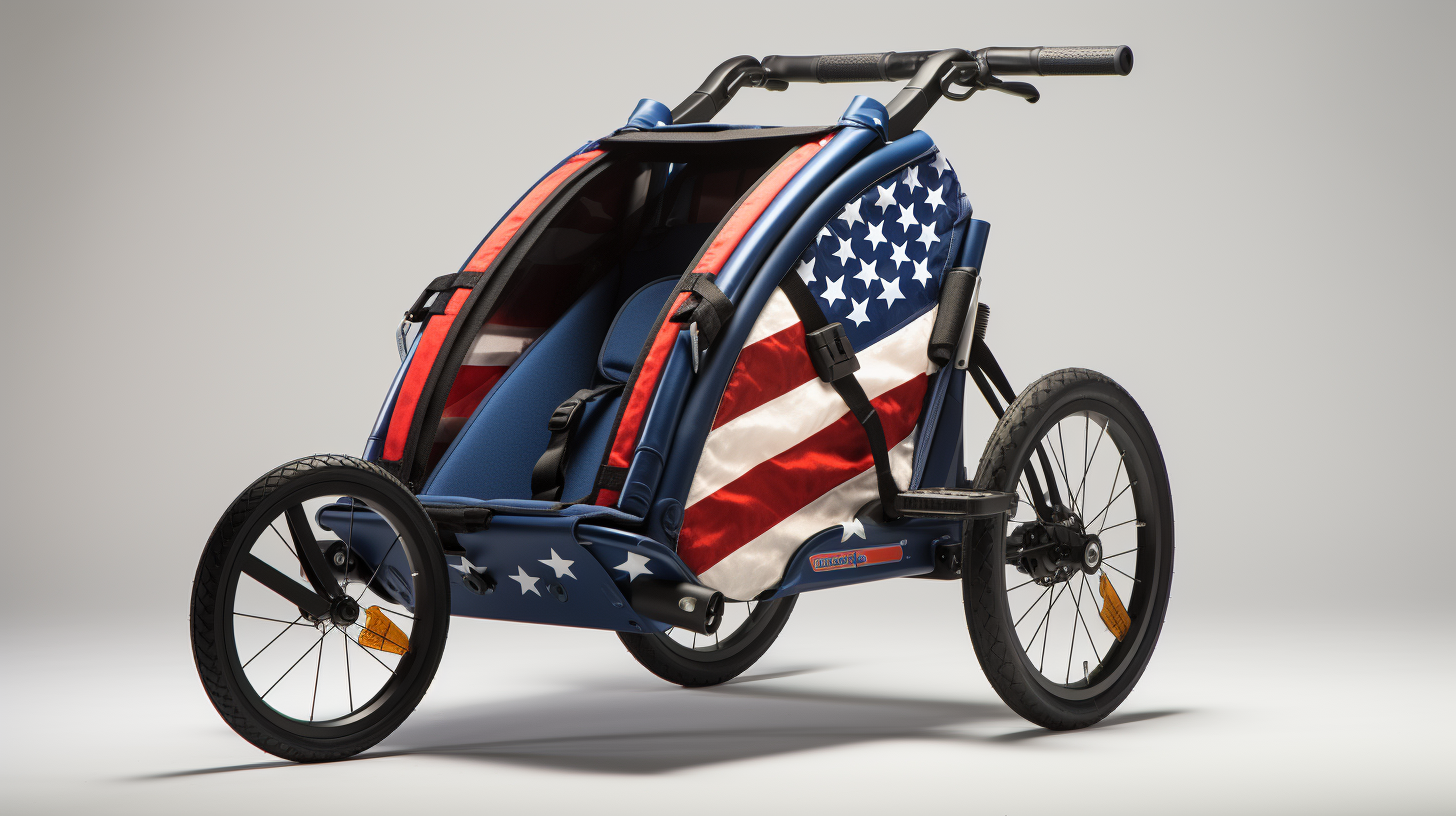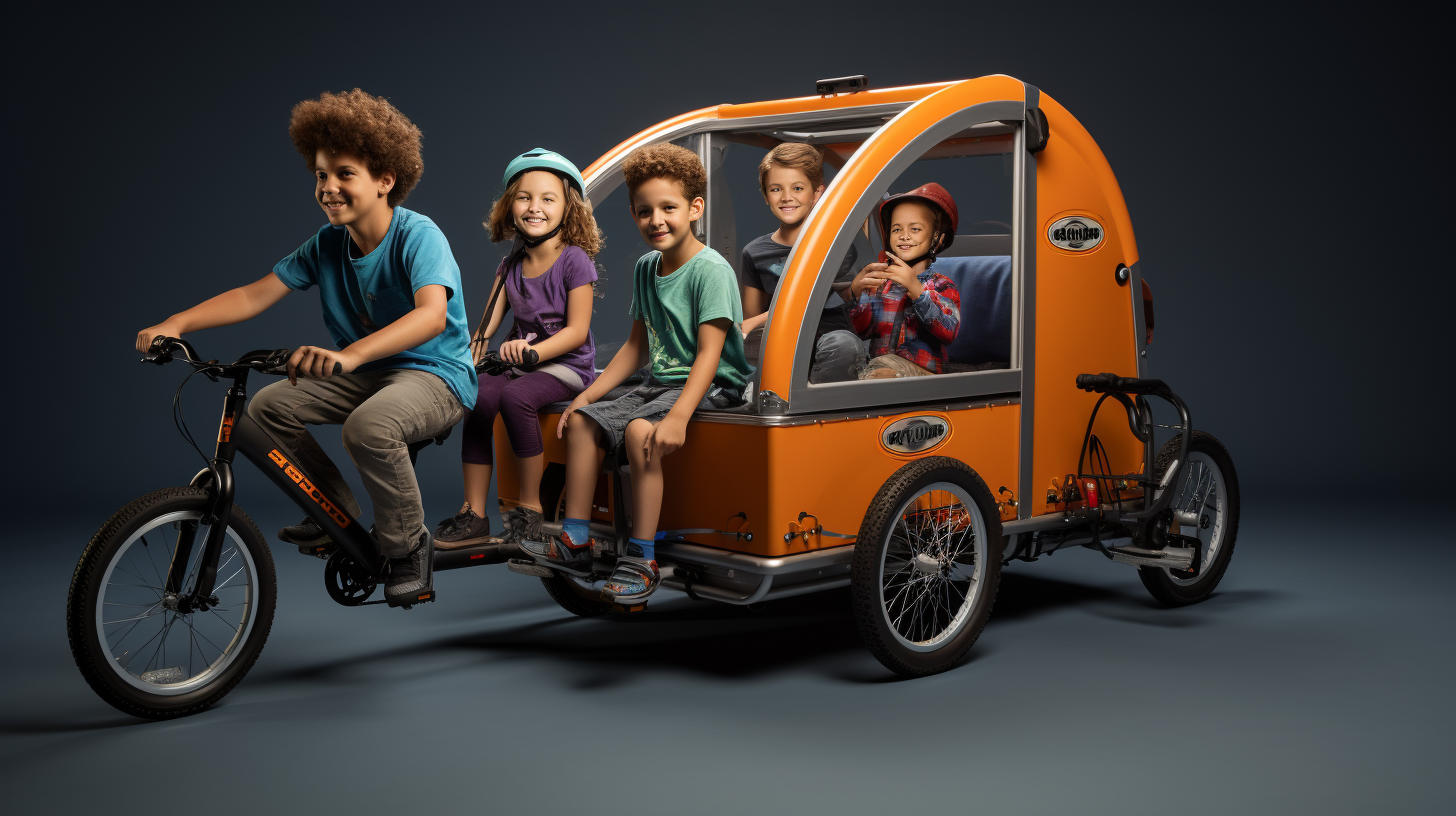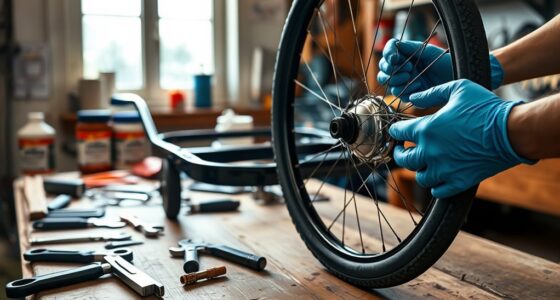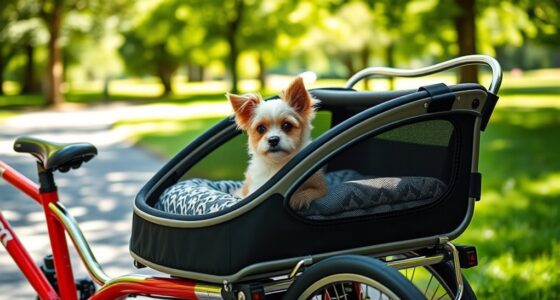As a parent, I understand the significance of selecting the perfect bike trailer for your children. These trailers offer a secure and fun way to take your kids on cycling outings with you.
But how do they actually attach to your bike? In this article, we’ll explore the various attachment methods, including rear axle, frame mount, quick release, seatpost, and hitch attachments.
We’ll also discuss factors like installation ease, durability, weight limit, and safety considerations.
So let’s dive in and discover the perfect attachment method for your family’s biking needs.
Key Takeaways
- Kids bike trailers can be attached to bikes using various methods, including rear axle attachment, frame mount attachment, quick release attachment, seatpost attachment, hitch attachment, and pin and clip attachment.
- Quick release and pin and clip attachments are generally easier to install, while frame mount and hitch attachments may require more adjustments.
- Rear axle and frame mount attachments are typically more durable, while quick release and seatpost attachments may have more movement. Hitch attachments can be durable but may require maintenance.
- Different attachment methods have different weight limits, with rear axle and frame mount attachments able to handle higher weights, quick release and seatpost attachments having lower weight limits, and hitch attachments varying in weight limit depending on design.
Rear Axle Attachment
Kids bike trailers typically attach to the bike’s rear axle using a quick-release mechanism. This method of attachment offers several advantages. Firstly, attaching the trailer to the rear axle provides excellent stability and balance while riding. The weight of the trailer is evenly distributed, minimizing any impact on the bike’s handling. Additionally, the rear axle attachment allows for easy maneuverability, as the trailer follows the exact path of the bike. This ensures a smooth and seamless ride for both the cyclist and the child in the trailer.
To properly install a bike trailer using rear axle attachment, follow these techniques. Start by locating the quick-release lever on the rear axle. Loosen the lever and slide the trailer attachment arm onto the axle until it is secure. Tighten the quick-release lever to hold the attachment arm firmly in place. Ensure that the attachment arm is aligned parallel to the bike’s frame and that it does not interfere with the bike’s chain or gears. Finally, give the trailer a gentle tug to verify that it is securely attached.
Moving on to frame mount attachment…
Frame Mount Attachment
To attach the bike trailer to your bicycle using a frame mount attachment, you’ll need to secure it to the rear frame of your bike. This type of attachment provides a secure and stable connection between your bike and the trailer, ensuring the safety of your child or children during the ride.
One of the advantages of frame mount attachments is their compatibility with different frames. Whether you have a mountain bike, road bike, or hybrid bike, you can easily find a frame mount attachment that fits your bike’s frame. This makes it convenient for parents who have multiple bikes or may want to switch the trailer between different bikes.
In terms of ease of use for parents, frame mount attachments are relatively straightforward to install and remove. Most frame mount attachments come with a quick release mechanism, allowing you to easily attach or detach the trailer from your bike. This saves time and effort, especially when you’re in a hurry or need to switch between using the bike trailer and riding solo.
Speaking of quick release attachments, let’s move on to the next section to explore this option in more detail.
Quick Release Attachment
When attaching the trailer using a quick release attachment, you’ll find it easy to securely connect and disconnect the trailer from your bike. This type of attachment offers several advantages and disadvantages that you should consider:
- Convenience: The quick release attachment allows for swift and effortless installation and removal of the trailer. This is especially useful when you need to switch between riding with and without the trailer quickly.
- Versatility: With a quick release attachment, you can easily attach the trailer to different bikes without the need for additional tools or adjustments. This makes it convenient for families with multiple bikes.
- Stability: Although quick release attachments provide convenience, they may not be as stable as other attachment methods, such as frame mounting. The trailer might have some lateral movement during rides, which can affect stability and control.
Transitioning into the subsequent section about ‘seatpost attachment,’ it’s important to note that seatpost attachment offers an alternative method to connect your bike trailer.
Seatpost Attachment
Before diving into seatpost attachment, let’s explore another option for connecting your bike trailer.
Seatpost attachment offers a convenient and easy way to connect your bike trailer to your bicycle. This method involves attaching the trailer to the seatpost of your bike using a specially designed clamp.
One of the key advantages of seatpost attachment is its compatibility with different bikes. Most bike trailers come with adjustable clamps that can fit a wide range of seatpost sizes. This means that regardless of the size of your seatpost, you can easily attach your bike trailer without any hassle.
Seatpost attachment is also incredibly easy to use. Once you have adjusted the clamp to fit your seatpost, you simply need to tighten it securely. This ensures that the trailer stays firmly attached to your bike throughout your ride. When you’re ready to detach the trailer, you just need to loosen the clamp and remove it from the seatpost.
Now that we have explored the seatpost attachment option, let’s move on to another method of connecting your bike trailer: hitch attachment.
Hitch Attachment
If you’re looking for a different method, hitch attachment provides a secure and reliable way to connect your bike trailer to your bicycle. When it comes to attaching a kids bike trailer to a bike, there are a few different options available. One popular choice is the hitch attachment, which allows you to connect the trailer directly to the rear axle or frame of your bike.
The hitch attachment offers several advantages over other methods, such as frame attachment. One of the main benefits is that it provides a more stable connection between the bike and the trailer. This means that the trailer will stay securely attached, even if you’re riding over bumpy terrain or making sharp turns. Additionally, the hitch attachment allows for better maneuverability, as it allows the trailer to move independently from the bike.
However, there are also some drawbacks to using a hitch attachment. One potential downside is that it can be more complicated to install compared to frame attachment. You may need to make adjustments to your bike’s rear axle or frame to accommodate the hitch. Additionally, the hitch attachment may be more expensive than other attachment methods.
Now, let’s transition to the next section about pin and clip attachment, which offers another option for connecting a bike trailer to a bike.
Pin and Clip Attachment
The pin and clip attachment provides a simple and secure way to connect your trailer to your bicycle. This type of attachment consists of a pin that slides through the trailer’s hitch and the bike’s rear axle, and a clip that holds the pin in place.
Here are some advantages and disadvantages of using a pin and clip attachment:
Advantages:
- Easy to install: The pin and clip attachment can be quickly and easily attached to your bicycle without the need for any special tools.
- Secure connection: The pin and clip provide a secure attachment, ensuring that the trailer stays firmly connected to the bike while riding.
- Versatility: Pin and clip attachments are compatible with a wide range of bike trailer models, making them a versatile option for different trailers.
Disadvantages:
- Limited weight capacity: Pin and clip attachments are typically designed for lighter loads, so they may not be suitable for larger or heavier trailers.
- Less stability: Compared to other attachment methods, such as ball and socket, pin and clip attachments may provide slightly less stability and may not be as suitable for rough terrains.
When choosing the right pin and clip attachment, consider the weight capacity of your trailer, the compatibility with your bike’s rear axle, and the type of terrain you will be riding on. Now, let’s move on to the next section about the ball and socket attachment, which offers its own set of advantages and disadvantages.
Ball and Socket Attachment
When choosing between ball and socket attachments, it’s important to consider their advantages and disadvantages for your specific needs.
The ball and socket mechanism is a popular choice for many applications due to its versatility and reliability. One of the main benefits of a ball and socket attachment is its ability to provide a wide range of motion. The ball joint allows for smooth rotation in multiple directions, making it ideal for applications that require flexibility and maneuverability.
Additionally, the ball and socket attachment provides a secure and stable connection. The ball joint is designed to fit snugly into the socket, ensuring that the attachment remains in place during use. This eliminates the risk of accidental disconnection and provides peace of mind.
However, it’s important to note that ball and socket attachments may require regular maintenance to ensure optimal performance. Lubrication and cleaning are often necessary to prevent wear and tear, which can affect the attachment’s functionality.
In conclusion, the ball and socket attachment offers many benefits, including a wide range of motion and a secure connection.
Now, let’s explore the latch and lock attachment, which provides a different set of advantages.
Latch and Lock Attachment
Transitioning from the previous subtopic on the ball and socket attachment, we now move on to another common method of attaching kids bike trailers to bikes – the latch and lock attachment. This method offers a secure and reliable connection between the trailer and the bike, ensuring a smooth and safe ride for both parent and child.
When it comes to latch and lock compatibility, it’s important to ensure that both your bike and the trailer are equipped with the necessary components. Here are some key points to consider:
- Compatibility: Check if your bike and trailer are designed to work together with a latch and lock attachment system. Some trailers come with universal compatibility, while others may require specific adapters.
- Installation Process: Begin by attaching the latch mechanism to your bike’s rear axle or seat post, depending on the design. Next, connect the trailer’s latch to the installed mechanism, ensuring a secure fit. Finally, engage the lock mechanism to keep the trailer firmly in place.
- Security: The latch and lock attachment provides an added layer of security, preventing any accidental detachment during the ride. Always double-check the connection before setting off.
- Adjustability: Some latch and lock systems offer adjustable features, allowing you to fine-tune the attachment to your specific bike and trailer setup.
- Ease of Use: With practice, the latch and lock attachment becomes a straightforward process, making it convenient for quick setup and removal.
Moving forward, let’s explore the importance of safety strap attachment in ensuring a safe and comfortable ride for your child without compromising their security.
Safety Strap Attachment
To ensure a safe ride for your child, make sure you securely fasten the safety straps when attaching the trailer. The safety straps are an essential part of the installation process for kids’ bike trailers. They provide an extra layer of security and prevent the trailer from detaching during the ride.
Before attaching the trailer, carefully read the manufacturer’s instructions and familiarize yourself with the specific safety strap requirements for your trailer model. Most trailers come with adjustable safety straps that can be easily fastened to the bike frame or seatpost. These straps are usually made of durable materials like nylon or polyester, ensuring their longevity and durability.
It is crucial to regularly inspect the safety straps for any signs of wear and tear. If you notice any fraying, stretching, or damage, it is important to replace them immediately. Proper maintenance of the safety straps is essential to ensure their effectiveness.
In the next section, we will explore the adjustable attachment options available for kids’ bike trailers, allowing you to find the best fit for your specific bike model without any hassle.
Adjustable Attachment Options
You can easily find the best fit for your specific bike model with the adjustable attachment options available for kids’ bike trailers. These attachment options allow for customization and ensure a secure and stable connection between your bike and the trailer.
Here are four key features of adjustable attachment options:
- Adjustable Height: The adjustable attachment options allow you to easily modify the height of the trailer’s connection to your bike. This ensures that the trailer is at the right level, providing a comfortable ride for your child and maintaining proper weight distribution.
- Weight Distribution: With adjustable attachment options, you can achieve optimal weight distribution between your bike and the trailer. This is particularly important when carrying heavy loads or navigating uneven terrain. Proper weight distribution ensures stability and control while riding.
- Easy Installation: The adjustable attachment options are designed for easy installation on different bike models. Most trailers come with universal attachment systems that can be adjusted to fit a variety of bike frames, ensuring a secure and hassle-free connection.
- Secure Locking Mechanism: The adjustable attachment options typically include a secure locking mechanism that keeps the trailer firmly attached to your bike. This prevents any accidental disconnection while riding, providing peace of mind and ensuring the safety of your child.
With these adjustable attachment options, you can confidently choose a kids’ bike trailer that fits your bike perfectly and offers a safe and enjoyable riding experience for both you and your child.
The compatibility with different bike models is another important aspect to consider when choosing a kids’ bike trailer.
Compatibility with Different Bike Models
The adjustable attachment options make it easy to connect the kids’ bike trailer to a variety of bike models. When it comes to bike trailer compatibility, choosing the right attachment is essential. Different bike models have different designs and specifications, so it’s important to select an attachment that fits securely and provides a stable connection.
To help you understand the compatibility options available, here is a table showcasing some common bike trailer attachment types and the bike models they are compatible with:
| Attachment Type | Compatible Bike Models |
|---|---|
| Rear Axle Mount | Mountain bikes, hybrid bikes |
| Seatpost Mount | Road bikes, city bikes |
| Frame Mount | Cruiser bikes, folding bikes |
| Quick Release | BMX bikes, kids’ bikes |
| Thru Axle Adapter | Fat bikes, electric bikes |
By referring to this table, you can easily determine which attachment type is suitable for your bike model. It’s important to note that some bike trailers come with multiple attachment options, allowing you to connect them to different bike models effortlessly.
Now that we understand the compatibility aspect, let’s move on to the next section, where we will discuss the ease of installation and removal of the bike trailer.
Ease of Installation and Removal
Installing and removing the bike trailer is a simple process that can be done quickly and easily. Here are four steps to guide you through the process:
- Attach the hitch: Begin by attaching the hitch to your bike’s rear axle. This is usually done by sliding the hitch onto the axle and securing it with a pin or quick-release mechanism. Ensure that the hitch is securely fastened to prevent any accidents while riding.
- Connect the trailer: Once the hitch is in place, simply connect the trailer to it. Most bike trailers have a coupler that easily slides onto the hitch. Make sure it clicks into place and give it a gentle tug to confirm that it’s securely attached.
- Adjust the safety straps: Before you hit the road, make sure to adjust the safety straps on the trailer. These straps are designed to keep your child safe and secure during the ride. Check that they are snug but not overly tight to ensure maximum comfort for your little one.
- Remove the trailer: To remove the trailer, simply reverse the steps. Disconnect the safety straps, detach the trailer from the hitch, and remove the hitch from your bike’s rear axle.
With the ease of installation and removal, you’ll find that using a bike trailer is a convenient way to transport your child.
Now let’s move on to the next section, where we’ll discuss the durability and stability of these trailers.
Durability and Stability
With their sturdy construction and reliable design, bike trailers remain stable throughout your rides. These trailers are built to last, ensuring durability and stability even on rough terrain. The frames of most bike trailers are made from lightweight yet strong materials like aluminum or steel, providing a stable foundation for your child’s safety. The wheels are designed to absorb shocks and vibrations, further enhancing stability and ensuring a smooth ride.
In terms of convenience and ease of use, bike trailers excel. Most models feature a simple attachment system that allows for quick and hassle-free installation. With just a few simple steps, you can securely attach the trailer to your bike, ready to hit the road in no time. Many trailers also come with a folding feature, making them easy to store and transport when not in use.
Transitioning into the next section about weight limit and capacity, it’s important to consider these factors when choosing a bike trailer. The durability and stability of the trailer are closely linked to its weight limit and capacity. It’s crucial to ensure that the trailer can safely accommodate the weight of your child and any additional cargo you may want to carry.
Weight Limit and Capacity
When choosing a bike trailer, you’ll want to make sure it can safely handle the weight of your child and any additional items you plan to carry. Here are some important factors to consider regarding weight capacity and age restrictions:
- Weight capacity: Look for a bike trailer that has a weight capacity suitable for your child’s size and age. Most trailers have weight limits ranging from 75 to 100 pounds. It’s essential to select a trailer that can accommodate your child’s weight comfortably to ensure their safety and the stability of the trailer during rides.
- Age restrictions: Bike trailers typically have age recommendations that indicate the appropriate age range for using the trailer. These recommendations are based on factors such as the child’s ability to sit upright and wear a helmet. Make sure to check the age restrictions provided by the manufacturer to ensure you choose a trailer that is suitable for your child’s age.
- Additional cargo capacity: Some trailers come with additional storage space for carrying items such as groceries or picnic supplies. Consider the weight capacity of the trailer, including both your child and any extra items you plan to carry, to ensure that you do not exceed the trailer’s limit.
- Consider future use: If you plan to use the bike trailer for several years, it may be wise to choose one with a higher weight capacity. This way, you can continue using the trailer as your child grows without worrying about exceeding the weight limit.
Considering the weight capacity and age restrictions of a bike trailer is crucial for ensuring the safety and comfort of your child during rides.
Now let’s move on to discussing the safety features and considerations of bike trailers.
Safety Features and Considerations
One important aspect to consider when choosing a bike trailer is the safety features it offers, such as reflectors and a five-point harness system. When it comes to bike trailers, visibility is crucial for the safety of both you and your child. Reflectors on the trailer’s sides and rear can greatly enhance visibility, especially during low-light conditions or when riding in busy areas. These reflectors bounce light back to its source, making you more noticeable to other road users.
Additionally, a five-point harness system is essential for securing your child safely inside the trailer. This system typically includes straps that secure the shoulders, waist, and crotch, ensuring that your child stays securely in place, even during bumpy rides.
Another important consideration for bike trailers is weather protection. Depending on where you live, you may encounter various weather conditions during your rides. Look for a trailer that offers a weather-resistant cover or rainfly to keep your child dry during unexpected rain showers. Additionally, some trailers come with a detachable sunshade to protect your child from harmful UV rays on sunny days. This feature is particularly important for long rides or when riding in areas with limited shade.
Frequently Asked Questions
Can a bike trailer be attached to a bike without a rear axle attachment?
Yes, a bike trailer can be attached to a bike without a rear axle attachment using alternative attachment methods.
One option is a front wheel attachment, which connects the trailer to the front wheel of the bicycle. This method involves mounting a special bracket or clamp onto the front fork of the bike, providing a secure connection point for the trailer.
It is important to ensure that the attachment is stable and can support the weight of the trailer and its occupants.
How do seatpost attachments work and are they compatible with all bike models?
Seatpost attachments are a popular alternative to rear axle attachments for bike trailers. They provide a secure connection between the trailer and the bike frame.
These attachments are compatible with various bike models, allowing for versatility. They work by clamping onto the seatpost of the bike, ensuring stability and balance while riding.
It’s important to check the compatibility of the seatpost attachment with different frame types, as some may require specific adapters or modifications.
Are there any safety considerations when using a hitch attachment for a bike trailer?
When it comes to bike trailer safety, there are a few important tips to keep in mind.
First, always ensure that the hitch attachment is securely fastened to the bike frame. Common types of hitch attachments include ball and socket, quick-release, and seatpost-mounted hitch systems.
Secondly, regularly check the hitch attachment for any signs of wear or damage.
Lastly, make sure the trailer is properly balanced and that the weight is evenly distributed to prevent any accidents or instability while riding.
What are the benefits of using a latch and lock attachment for a bike trailer?
I love using a latch and lock attachment for my bike trailer because it provides me with peace of mind and added security. The latch and lock mechanism ensures that the trailer is securely attached to my bike, eliminating any worries of it becoming detached during our rides.
This type of attachment also allows for quick and easy installation, making it convenient for me to attach and detach the trailer whenever I need to. Plus, the sturdy lock keeps the trailer firmly in place, providing a stable and smooth ride for my little ones.
Overall, the latch and lock attachment offers both safety and convenience, making it the perfect choice for any bike trailer.
Are there any adjustable attachment options available for bike trailers?
There are several adjustable attachment options available for bike trailers. One popular option is a universal hitch that can be adjusted to fit different bike frames.
Another option is a quick-release attachment that allows for easy installation and removal.
Additionally, some bike trailers come with alternative attachment methods, such as seatpost mounts or axle mounts.
These options provide flexibility and convenience, allowing you to easily attach your bike trailer to different bikes without any hassle.
Conclusion
In conclusion, when it comes to attaching kids bike trailers to bikes, there are several options available. From rear axle attachments to frame mount attachments, each method offers its own benefits and considerations.
However, one particular attachment method stood out to me during my research – the hitch attachment. It reminded me of a strong bond between two entities, like a rider and their bike, working together seamlessly to provide a safe and enjoyable biking experience for both parent and child.
With its ease of installation, durability, and safety features, the hitch attachment is certainly a top choice for many parents.
So, next time you’re considering a bike trailer for your little one, don’t forget to explore the hitch attachment option and experience the joy of biking together.









